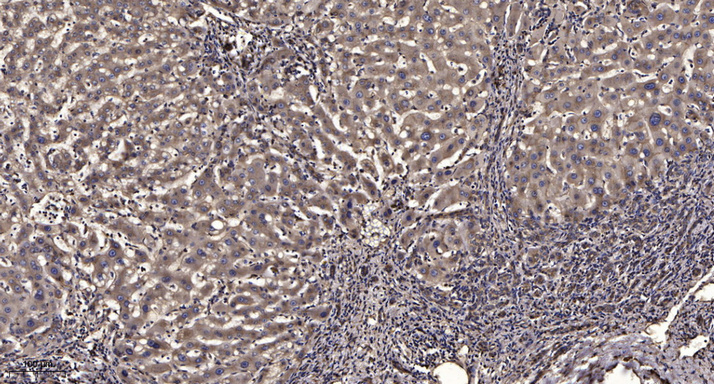Ku-70 (Acetyl Lys338) rabbit pAb
- Catalog No.:YK0154
- Applications:WB;IHC
- Reactivity:Human;Mouse
- Target:
- Ku70/XRCC6
- Fields:
- >>Non-homologous end-joining
- Gene Name:
- XRCC6 G22P1
- Protein Name:
- Ku-70 (Acetyl Lys338)
- Human Gene Id:
- 2547
- Human Swiss Prot No:
- P12956
- Mouse Gene Id:
- 14375
- Mouse Swiss Prot No:
- P23475
- Immunogen:
- Synthesized peptide derived from human Ku-70 (Acetyl Lys338)
- Specificity:
- This antibody detects endogenous levels of Human,Mouse Ku-70 (Acetyl Lys338)
- Formulation:
- Liquid in PBS containing 50% glycerol, 0.5% BSA and 0.02% sodium azide.
- Source:
- Polyclonal, Rabbit,IgG
- Dilution:
- WB 1:500-2000;IHC 1:50-300
- Purification:
- The antibody was affinity-purified from rabbit serum by affinity-chromatography using specific immunogen.
- Concentration:
- 1 mg/ml
- Storage Stability:
- -15°C to -25°C/1 year(Do not lower than -25°C)
- Other Name:
- X-ray repair cross-complementing protein 6 (EC 3.6.4.-;EC 4.2.99.-;5'-deoxyribose-5-phosphate lyase Ku70;5'-dRP lyase Ku70;70 kDa subunit of Ku antigen;ATP-dependent DNA helicase 2 subunit 1;ATP-dependent DNA helicase II 70 kDa subunit;CTC box-binding factor 75 kDa subunit;CTC75;CTCBF;DNA repair protein XRCC6;Lupus Ku autoantigen protein p70;Ku70;Thyroid-lupus autoantigen;TLAA;X-ray repair complementing defective repair in Chinese hamster cells 6)
- Observed Band(KD):
- 70kD
- Background:
- developmental stage:Expression does not increase during promyelocyte differentiation.,disease:Individuals with systemic lupus erythematosus (SLE) and related disorders produce extremely large amounts of autoantibodies to p70 and p86. Existence of a major autoantigenic epitope or epitopes on the C-terminal 190 amino acids of p70 containing the leucine repeat. The majority of autoantibodies to p70 in most sera from patients with SLE seem to be reactive with this region.,function:Single stranded DNA-dependent ATP-dependent helicase. Has a role in chromosome translocation. The DNA helicase II complex binds preferentially to fork-like ends of double-stranded DNA in a cell cycle-dependent manner. It works in the 3'-5' direction. Binding to DNA may be mediated by p70. Involved in DNA nonhomologous end joining (NHEJ) required for double-strand break repair and V(D)J recombination. The Ku p70/p86 dimer acts as regulatory subunit of the DNA-dependent protein kinase complex DNA-PK by increasing the affinity of the catalytic subunit PRKDC to DNA by 100-fold. The Ku p70/p86 dimer is probably involved in stabilizing broken DNA ends and bringing them together. The assembly of the DNA-PK complex to DNA ends is required for the NHEJ ligation step. Required for osteocalcin gene expression.,induction:In osteoblasts, by FGF2.,PTM:Phosphorylation by PRKDC may enhance helicase activity. Phosphorylation of Ser-51 does not affect DNA repair.,similarity:Belongs to the ku70 family.,similarity:Contains 1 Ku domain.,similarity:Contains 1 SAP domain.,subunit:Heterodimer of a 70 kDa and a 80 kDa subunit. The dimer associates in a DNA-dependent manner with PRKDC to form the DNA-dependent protein kinase complex DNA-PK, and with the LIG4-XRCC4 complex. The dimer also associates with NARG1, and this complex binds to the osteocalcin promoter and activates osteocalcin expression. In addition, the 70 kDa subunit binds to the osteoblast-specific transcription factors MSX2, RUNX2 and DLX5. Interacts with ELF3. Interactis with XRCC6BP1.,
- Function:
- telomere maintenance, non-recombinational repair, somatic diversification of immune receptors, immune system development, somatic diversification of immune receptors via germline recombination within a single locus, DNA metabolic process, DNA ligation, DNA repair, double-strand break repair, double-strand break repair via nonhomologous end joining, DNA recombination, regulation of transcription, DNA-dependent, regulation of transcription from RNA polymerase II promoter, response to DNA damage stimulus, response to radiation, response to abiotic stimulus, positive regulation of biosynthetic process, response to ionizing radiation, regulation of specific transcription from RNA polymerase II promoter, positive regulation of specific transcription from RNA polymerase II promoter, positive regulation of macromolecule biosynthetic process, positive regulation of macromolecule metabolic process
- Subcellular Location:
- Nucleus . Chromosome .
- June 19-2018
- WESTERN IMMUNOBLOTTING PROTOCOL
- June 19-2018
- IMMUNOHISTOCHEMISTRY-PARAFFIN PROTOCOL
- June 19-2018
- IMMUNOFLUORESCENCE PROTOCOL
- September 08-2020
- FLOW-CYTOMEYRT-PROTOCOL
- May 20-2022
- Cell-Based ELISA│解您多样本WB检测之困扰
- July 13-2018
- CELL-BASED-ELISA-PROTOCOL-FOR-ACETYL-PROTEIN
- July 13-2018
- CELL-BASED-ELISA-PROTOCOL-FOR-PHOSPHO-PROTEIN
- July 13-2018
- Antibody-FAQs
- Products Images

- Immunohistochemical analysis of paraffin-embedded human liver cancer. 1, Antibody was diluted at 1:200(4° overnight). 2, Tris-EDTA,pH9.0 was used for antigen retrieval. 3,Secondary antibody was diluted at 1:200(room temperature, 45min).


